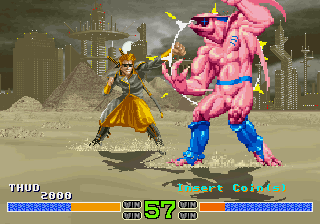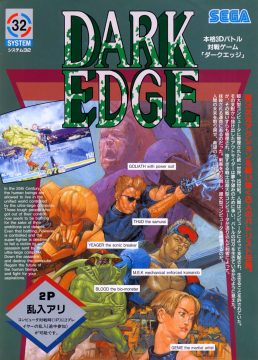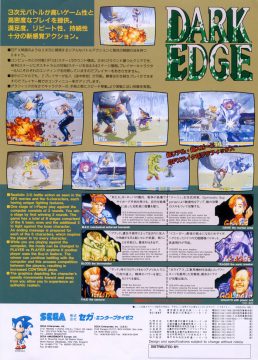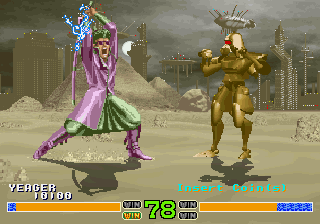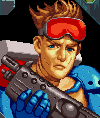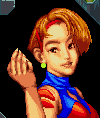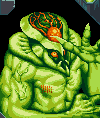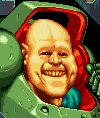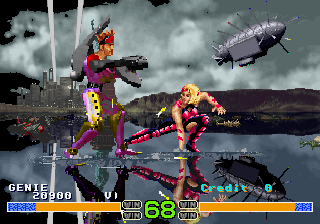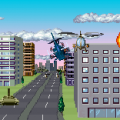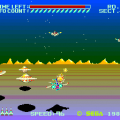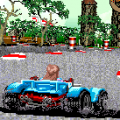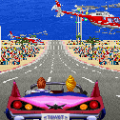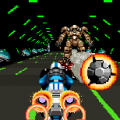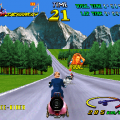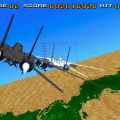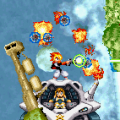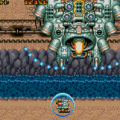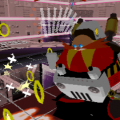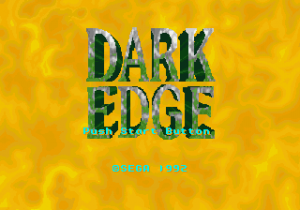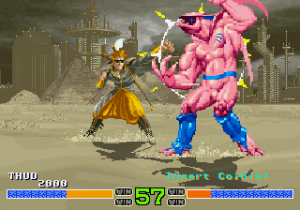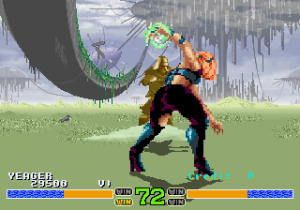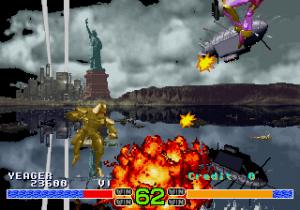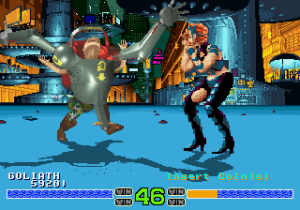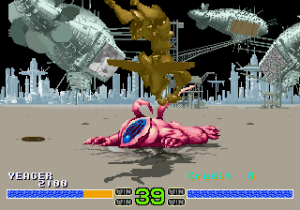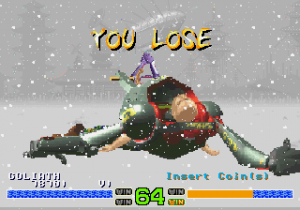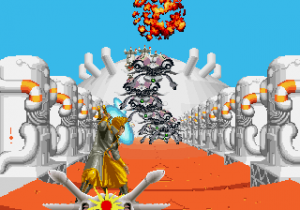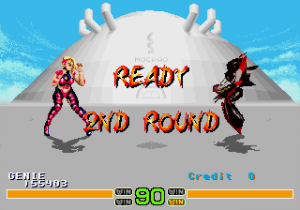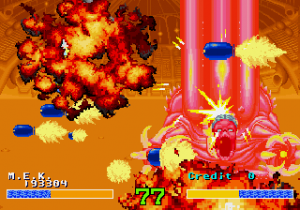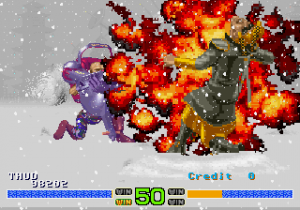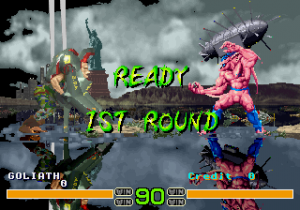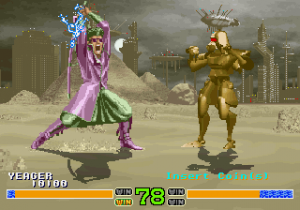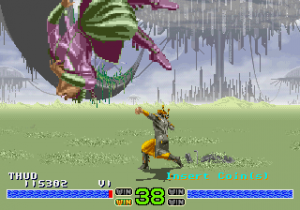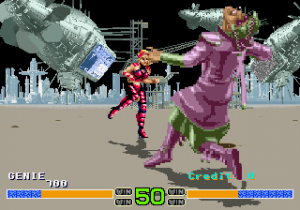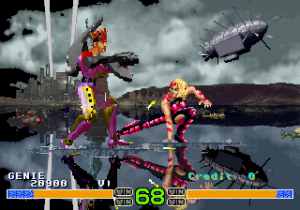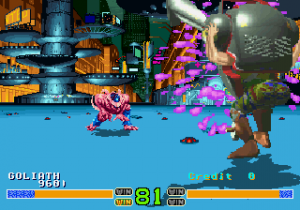With Virtua Fighter, Sega defined the basics of what would be expected from a 3D fighting game ever since, just like Capcom’s Street Fighter II had become a template for dozens of 2D imitators two years earlier. But before landing gold with Yu Suzuki’s smash hit, Sega had been doing a lot of groping into directions that didn’t really work out. Following shortly after the weird hologram machine Holosseum, Dark Edge was Sega’s first attempt at actual 3D gameplay in a fighting game. As it relied on the company’s well-proven sprite scaler technology instead of the still immature polygonal graphics of the Model 1, Dark Edge could easily be confused for a pure 2D game as long as the fighters stand waiting for the starting signal. In reality, however, it is more of a true 3D fighting game than most polygon-based games that followed it.
The setting is already very uncommon for a fighting game of the early 1990s – in this world of one international martial arts tournament after the other, this futuristic take with its megacities in the background sure was a refreshing change. Most of the six playable characters are some kind of cyberpunk stereotype. There’s a street samurai, a genetically mutated monstrosity, a skinny dude running around in a huge piece of armor… only the lone female combatant apparently is just some gal in an aerobics outfit (but with high heels). It’s a special cyber future aerobics outfit, of course, but you can’t really tell by looking at it. The manual introduces the fighters as follows:
Characters
M.E.K – mechanical enforced kommando
A European mercenary soldier wounded in the war underwent a cyborg operation and is determined to have revenge on the Boss who sent him to the battlefield.
Genie – the martial artist
A female martial artist who wears the Gymnastic Battle Suit that enhances her agility. She attacks the enemy by taking advantage of an unguarded moment.
Blood – the bio-monster
This monster man born as a result of genetic mutation has the weapons of elastic mass and sharp fins. He displays primitive instincts as a fighter as he discharges poisonous liquid.
Yeager – the sonic-breaker
A former German fighter pilot who became a cyborg in order to be the super-fighter. His special ability: High speed flight.
Thud – the Samurai
An American who has the Samurai spirit can use two swords skilfully. He believes in the spiritual power and controls the thunder.
Despite the far-out presentation, Dark Edge‘s structure is surprisingly conventional for the most part: Beat all six regular opponents in best-of-three matches, then move on to the bosses. Just as in Street Fighter II, every character has a handful of unique special moves and an ending cutscene that consists of three still images and a few lines of text that lack any context.
As soon as the fight starts, however, and the players try to jump or duck, it all goes crazy (there is a separate button for the former, though): Dark Edge is the first ever fighting game with fully realize 8-way movement. Unfortunately, the graphics aren’t that good at conveying minute differences in depth, so the direction the characters are facing is all there is to help with orientation in the 3D space. But the camera is the bigger problem: Other than in most “real” 3D fighters, in which it mostly keeps rotating with the characters to preserve a sense of direction, here the camera is fixed. That means each time the positioning in relation to the viewpoint changes, players have to work their heads around the changed directions. When the character is with the back towards the screen, for example, a horizontal charge move starts by pressing the lever diagonally back and down. Those who now started to worry how to wrap their heads around quarter or even half circle movements in this setup can relax: Those actually always work as if on a 2D plane. The game only recognizes 6 directions, so there is no viewpoint for them to look straight into or out of the screen, and characters are always standing either to the left or right to some degree. However, you still have to deal with very frequent switches between left and right, resulting in many failed attempts at special moves. The whole game is dominated by a strong feeling of not really being in control of the situation.
In consequence, actually getting through the single player mode is excruciatingly hard, even when selecting the lowest difficulty level in the service menu. A mortal human being just doesn’t stand much of a chance against AI opponents who don’t ever have to worry about what direction they’re facing at any given time. So getting to see all the endings will demand a lot of sweat and tears, although the game isn’t terribly long, even considering its genre: After defeating all six regular characters (including a doppelganger of the one chosen as the player avatar) follows an interesting but short Space Harrier-like bonus stage, where the player rides on some kind of mini jet and shoots at drones on his way to the Master’s Mocpao (no idea what that means, it just says so written on the outer wall). There awaits a very mean mini boss, a missile-spamming black robot. He’s actually harder to beat than the Master himself, who just sits around shooting in all directions and only has to be beaten in one round.
Oddly enough, the game’s greatest flaw seems to lie in embracing the third dimension too much. All the more successful 3D fighting games that followed, like Virtua Fighter or Tekken, severely limited the use of the third axis, up until 1998, when Soul Calibur re-introduced full free 8-way movement. All things considered, Dark Edge hardly seems like a commercial grade product, and rather like a weird experiment some SEGA engineer might have toyed with in his spare time, and somehow it wound up becoming a full game. Today it is best viewed as an interesting outlook at what could have been done in a world without polygons, and a rather good looking one at that. Sure, to say the pixellated characters in front and the flat images in the back have aged badly is easy now, but back in early 1993, the zenith of polygon-based 3D had been Alone in the Dark and Virtua Racing, and with its fast-scaling action, weather and special move effects, Dark Edge must have seemed like a true alternative to the slow, chiseled and awkwardly animated human characters in those games.
